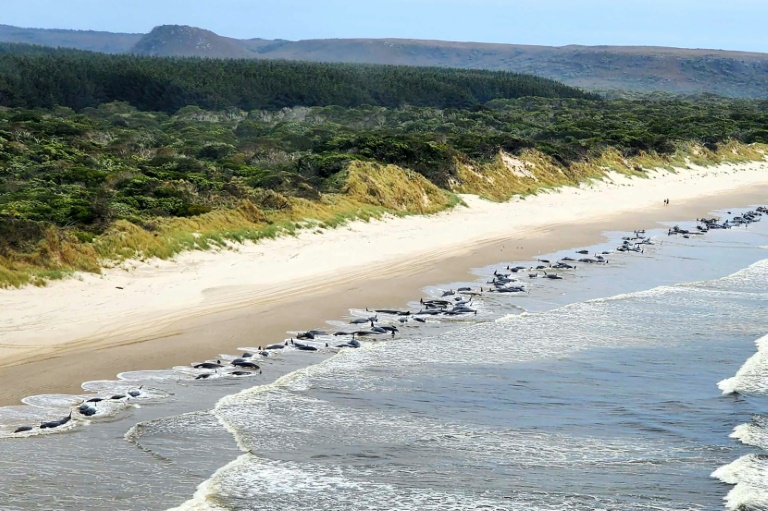Pilot whales beached on Macquarie Harbour, in Tasmania
About 200 pilot whales have perished after being stranded on an exposed, surf-swept beach on the rugged west coast of Tasmania, Australian rescuers said Thursday.
Just 35 of the approximately 230 whales discovered on the beach the day before were still alive, the state’s wildlife service operations manager, Brendon Clark, told journalists at the scene.
Aerial images have revealed dozens of glossy, black mammals strewn across Ocean Beach, stuck on the waterline where the frigid southern ocean meets the sand.
“We have got about 35 surviving animals out on the beach and the primary focus this morning will be on the rescue and release of these animals,” said Clark, who is managing the incident.
“Unfortunately we do have a high mortality rate on this particular stranding. That’s predominantly due to the exposed conditions out on Ocean Beach,” he added.
“The environmental conditions, the surf out there on the exposed west coast, Ocean Beach, is certainly taking its toll on the animals.”
Locals had covered whales with blankets and doused them with buckets of water to keep them alive after they were discovered on the beach.
Two years ago nearby Macquarie Harbour was the scene of the country’s largest-ever mass stranding, involving almost 500 pilot whales.
More than 300 pilot whales died during that stranding, despite the efforts of dozens of volunteers who toiled for days in Tasmania’s freezing waters to free them.
Clark said the conditions of the latest stranding were tougher for the whales than two years ago, when the animals were in “much more sheltered waters”.
– Distress signals –
Rescuers had triaged whales in the latest stranding to identify those with the best chance of survival, he said.
“Today’s focus will be on rescue and release operations.”
The cause of mass strandings is still not fully understood.
Scientists have suggested they could be caused by pods going off track after feeding too close to shore.
Pilot whales — which can grow to more than six metres (20 feet) long — are highly sociable and can follow podmates who stray into danger.
That sometimes occurs when old, sick or injured animals swim ashore and other pod members follow, trying to respond to the trapped whale’s distress signals.
Others believe gently sloping beaches such as those found in Tasmania confuse the whales’ sonar making them think they are in open waters.
The latest stranding came shortly after a dozen young male sperm whales were reported dead in a separate mass stranding on King Island — between Tasmania and the Australian mainland.
The young whales’ deaths may be a case of “misadventure”, wildlife biologist Kris Carlyon from the state government conservation agency told the local Mercury newspaper.
In nearby New Zealand strandings are also common.
There, around 300 animals beach themselves annually, according to official figures and it is not unusual for groups of between 20 and 50 pilot whales to run aground.
But numbers can run into the hundreds when a “super pod” is involved — in 2017, there was a mass stranding of almost 700 pilot whales.









